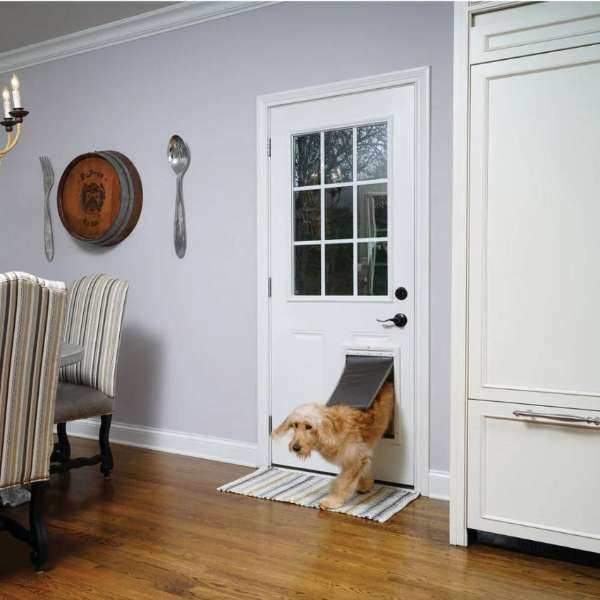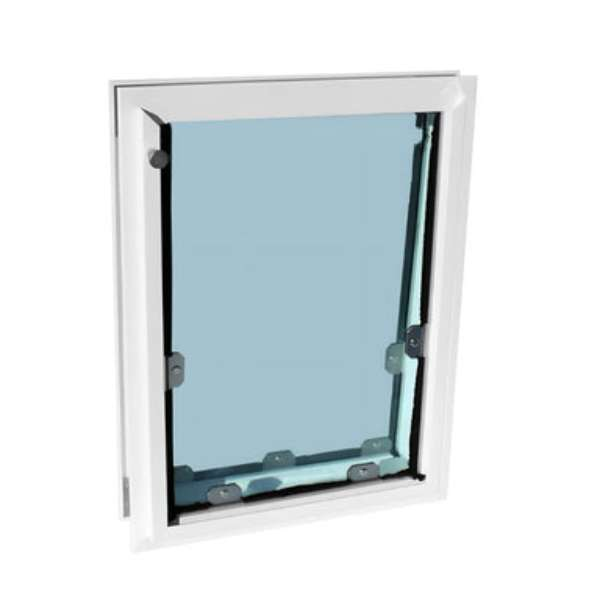On a rainy Sunday afternoon, you're cozy at home with your favorite book and a warm cup of tea. Just as the story reaches its climax, your dog begins scratching at the door, signaling the need to go outside. Reluctantly, you put down your book, stand up, and let your furry companion out. But within moments, they're back, scratching again to come back in. It’s frustrating, isn’t it?
We’ve all been there. Installing a dog door seems like the perfect solution, but not all pet doors are created equal. Picking the wrong one can bring along a whole new set of challenges. That’s where we come in. Let’s explore the various options for dog doors, steer clear of common pitfalls, and discover the ideal fit for you and your pet.
No matter if you're a first-time dog owner or looking to upgrade your current setup, by the end of this guide, you'll know exactly how to select the best dog door to make life easier for both you and your pet.
### Mistake #1: Choosing the Wrong Size
Ensuring the right size for your pet door is critical. A door that’s too small can be uncomfortable and might even discourage your dog from using it. On the other hand, a door that’s too large poses a security risk, potentially allowing unwanted visitors to enter.
Accurately measuring your dog is essential. Here's how:
- **Height**: Measure from your dog’s shoulder (withers) to the bottom of their chest or belly.
- **Width**: Measure the widest part of your dog, typically across the shoulders or hips, based on their body type.
- **Clearance**: Measure the distance from the ground to the bottom of your dog’s chest to determine the appropriate height for the door, ensuring they don’t have to jump awkwardly.
Many pet owners mistakenly guess the size or assume their dog won’t grow much more, which can be particularly problematic with puppies. They grow faster than expected, and a door that fits now might soon become too small.

Always account for your puppy’s adult size when selecting a door.
---
### Mistake #2: Overlooking Climate Considerations
Living in a colder region? An insulated pet door is non-negotiable. These doors are designed for energy efficiency, keeping the cold out and warmth in. Without insulation, you’ll face higher heating bills and an uncomfortably chilly home.
Non-insulated doors can let in drafts, making your living space less cozy and forcing your heating system to work harder.
In warmer climates, the sun can wreak havoc. UV-resistant pet doors are ideal here. They prevent excessive heat from entering your home, keeping it cool and protecting the door from warping or becoming brittle.
If you install a regular door in such climates, it can lead to warping, reducing the door’s lifespan and efficiency. So, what should you look for?
- **Insulated Doors**: For colder regions, opt for doors with good insulation like the Security Boss SB72W Wall Mount Insulating Dog Door. Some even feature double flaps or magnetic seals to keep the cold out.
- **UV-Resistant Doors**: In hot climates, choose doors made from durable, UV-resistant materials to ensure longevity and cooler interiors.
- **All-Weather Doors**: If you experience both extremes, consider all-weather doors designed to handle both cold winters and hot summers.
---
### Mistake #3: Underestimating Security
A poorly secured pet door can attract more than just your pet—it can also invite intruders or neighborhood pests. Ensuring your dog door is secure is vital.
- **Locking Mechanisms**: Basic doors come with simple locks like the Watchdog Security Pet Doors Cover, but advanced options offer multiple locking points. Look for doors that allow locking from both inside and outside.
- **Electronic Controls**: High-tech doors use your pet’s microchip or a special collar key to unlock only for them, such as the PetSafe Electronic Lockable Patio Dog Door.
- **Sensor Systems**: Some doors come equipped with sensors that detect your pet’s presence. These systems open when your dog approaches and close securely afterward.

---
### Mistake #4: Neglecting Installation Compatibility
Installing a dog door might seem straightforward, but improper installation can lead to issues. One common mistake is diving into a DIY project without the proper tools or instructions.
Even though it might look easy on YouTube, each dog door and home setup is unique. Mishaps can result in a poorly fitted door that’s insecure or inefficient.
#### Step-by-Step Guide to Installing a Dog Door:
1. **Read the Instructions**: Start by carefully reading the manufacturer’s instructions. Skipping this step is where many go wrong.
2. **Gather the Right Tools**: Ensure you have all necessary tools before starting, including a jigsaw, drill, measuring tape, and level.
3. **Measure Twice, Cut Once**: Carefully measure the placement of the dog door. Double-check your measurements to avoid cutting too large or too small an opening.
4. **Mark the Outline**: Use a pencil to mark where you’ll cut. This ensures precision.
5. **Cut the Opening**: Follow the outline with your jigsaw, ensuring clean, straight edges.
6. **Install the Frame**: Place the dog door frame into the opening and check for a snug fit before securing it with screws.
7. **Seal the Edges**: Use weatherproofing materials to seal around the edges, preventing drafts and leaks.
8. **Test the Door**: Ensure the door swings or slides smoothly. Adjust as needed to ensure it works perfectly for your dog.
For detailed instructions, visit [How To Install Dog Doors In A Door](https://www.example.com/how-to-install-dog-doors).
If you’re not comfortable installing the door yourself, it’s best to call a professional. They’ll ensure proper installation, saving you time and potential frustrations.
---
### Mistake #5: Cutting Corners on Quality
The materials used in your dog door significantly impact its durability, security, and performance. Here’s a breakdown of common materials and their pros and cons:
- **Plastic Dog Doors**: Lightweight and affordable, these are easy to install and available in various sizes. However, they wear out quickly with frequent use and are prone to damage from chewing or scratching.
- **Aluminum Dog Doors**: Durable and secure, aluminum doors can handle frequent use and resist chewing and scratching. While pricier, they’re worth it for larger or more active dogs. Professional installation may be required for certain setups.
- **Vinyl Dog Doors**: Offer a balance between durability and flexibility. Vinyl is weather-resistant and provides insulation, making it suitable for both hot and cold climates. While more costly than plastic, vinyl is generally cheaper than aluminum.
While saving money initially might be tempting, low-quality materials often lead to higher costs in the long run due to frequent replacements and repairs.

For high-traffic areas, aluminum doors are the best choice due to their durability and resistance to damage. For moderate use, vinyl doors offer a good balance between cost and durability, providing weather resistance and insulation. If budget is a concern, look for higher-quality plastic doors with reinforced edges to extend their lifespan.
---
### Mistake #6: Ignoring Your Dog’s Age and Mobility
Puppies grow quickly, so a door that fits now might soon be too small. Choosing a door that accommodates their future size saves you the trouble of upgrading later. Ensure the door is easy to use, with no sharp edges or heavy flaps that could be difficult for them to push.
As dogs age, they may develop joint issues or arthritis, making it hard for them to jump or push through a heavy door. Look for doors with lower step-over heights and wide openings for comfortable movement. Features like gentle magnetic closures and lightweight flaps can make a significant difference, especially for dogs with conditions like hip dysplasia or arthritis.
---
### Mistake #7: Skipping Training
Even the best dog door can become a source of frustration without proper training. Patience is key—your dog needs to feel safe and confident using the door. Scolding or punishing them for not using it can create a negative association. Instead, focus on positive reinforcement.
Start by letting your dog explore the door while it’s propped open. Use treats and praise to make it a positive experience. Gradually encourage them to push it open with their nose or paws, rewarding them every time they succeed. Consistency is crucial—practice several times a day, but keep sessions short and enjoyable.
Positive reinforcement techniques like treats and praise are essential. Reward your dog generously when they use the door correctly.
---
### Finding the Best Dog Door for Your Home
Selecting the right dog door can make life easier for both you and your furry friend. By avoiding these common mistakes, you can enjoy a smooth, hassle-free experience. Taking the time to choose the right door and install it properly can save you from future headaches.
For more tips on dog ownership and puppy products, visit our blogs.
---
Pet doors are more than just a practical addition—they’re a way to enhance your pet’s independence and comfort. By learning from these common mistakes, you’ll ensure a seamless integration of your pet door into your home.
Wood Fired Pizza Oven
Wood-fired ovens come in various styles and sizes, ranging from portable outdoor ovens to large, built-in units found in restaurant kitchens. Despite advancements in technology, the fundamental principle of using burning wood to create even, high temperatures for baking remains consistent over the centuries.
Wood-fired ovens are specifically designed for cooking pizzas using wood as the primary heat source. The wood fire heats up the bricks inside the oven, providing the perfect cooking surface for the pizza.
These ovens typically use dried hardwoods like maple, oak, hickory, and walnut to generate optimal flames and smoke. These hardwoods burn cleanly and impart excellent flavors to the food.
Once the wood-fired oven reaches full temperature, pizzas are cooked at incredibly high temperatures, ranging from 750° to 850° Fahrenheit. This intense heat allows pizzas to cook in a rapid 2 to 3 minutes, resulting in a charred crust that adds to the flavor profile.
Outdoor Portable Wood Fired Pizza Oven,12 Inch Wood Fired Pizza Oven,16 Inch Wood Fired Pizza Oven
GFTOP , https://www.ovenchief.com